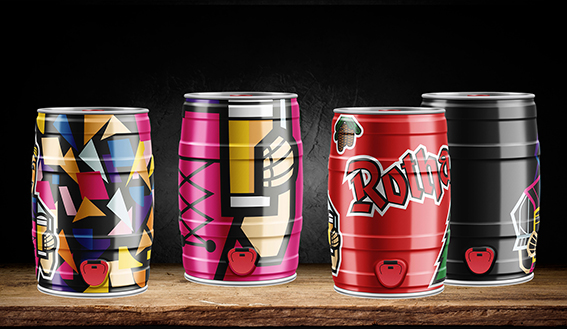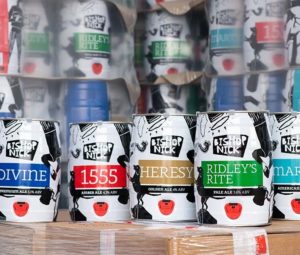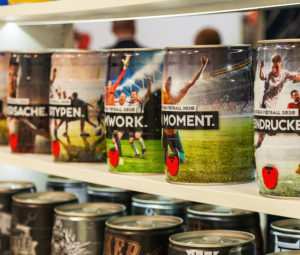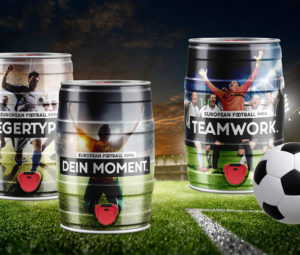A cubist-looking female figure holds two beer glasses towards you smiling. Surrounding it are geometric shapes that glow brightly on a black background. What looks like a modern work of art at first glance is actually a party beer keg. To be more precise, it is one of the four new minikegs from Rothaus. It shows the characteristic Black Forest girl, which has already adorned the brewery’s products as a brand logo for 50 years. What’s special about it is that Rothaus has completely reinterpreted its traditional design with this limited special collection.
“Biergit Kraft” is the name of the cheerful lady, a genuine High Black Forest woman in a typical cheek hat costume. Rothaus beer drinkers gave her this fictitious name in the 1990s. It is based on the saying “Beer gives you strength” (“Bier gibt Kraft”). Today, “Biergit” adorns not only beer labels, but also backpacks, pocket knives and key chains. She even has her own Twitter account. So it’s no surprise that her fan base is also growing steadily beyond the Black Forest!
With courage and flair: traditional design reinterpreted
The Rothaus State Brewery in Baden has been advertising with the Black Forest girl since the 1950s – at that time as a photo-realistic illustration. Since 1972, her graphically stylized portrait has adorned the beer labels of the popular Rothaus “Zäpfle”. While other brands are doing everything they can to give their products a modern touch, the Black Forest brewery has stuck to the traditional logo unchanged for 50 years. A brand relaunch? Unthinkable for Rothaus! Instead, the brewery has managed to do exactly what many fail to do: with courage and flair, it has repeatedly reinterpreted its traditional design over the years.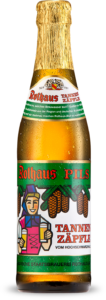
“It’s always exciting to see how the consumer reacts to it,” says Daniel Weishaar, who is the team leader responsible for internal sales/export at Rothaus. He considers the four new kegs in the special edition to be quite ” daring”. This is because they take up the “Biergit” theme in a much more hidden or playful way than previous designs. Sometimes only an oversized section of the characteristic woman’s logo is shown, sometimes the complete Biergit is shown as an outline drawing. Bright colors and striking contrasts give the traditional design a modern look. The Rothaus lettering has even been completely omitted from some minikeg designs. Daniel Weishaar is nevertheless certain: “Anyone who knows the brand will also recognize that these are Rothaus kegs.” In any case, the new kegs achieve one thing: they immediately catch the eye on the beverage shelf!
The Rothaus brewery is best known for its “Tannenzäpfle“. The spicy, fresh Pilsner is the classic among Rothaus beers and the eponym of the “Zäpfle family”. Tannenzäpfle” has been Germany’s strongest beer brand for several years – even ahead of “TV beers” such as Krombacher and Erdinger. This is the result of the “Brand Index 2021” by market researchers Yougov and Handelsblatt, which surveyed 900,000 consumers in an online poll. Although relatively expensive, “Tannenzäpfle” is also very popular with young people and has long since become a cult drink in many major cities.
Rothaus is a pioneer in climate protection
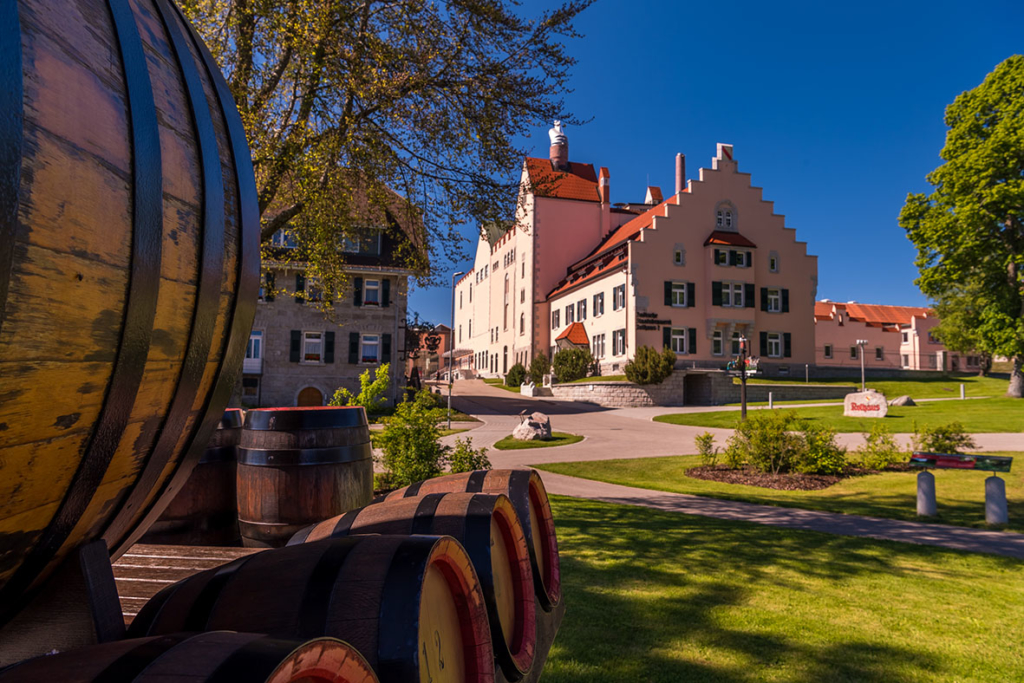
Exterior view of the Rothaus brewery
Where does that come from? For one thing, of course, because of what the brand stands for. “Values such as home, tradition, consistency, and tranquility have a high priority among our consumers, especially in our turbulent world,” emphasizes Daniel Weishaar. As a state brewery, Rothaus naturally feels particularly committed to these values. It is not for nothing that Rothaus is also taking on a pioneering role in climate protection. The brewery is already among the top 10 in Europe in terms of energy consumption. By 2030, Rothaus even wants to produce in a “climate-positive” way, i.e. compensate more CO2 than it causes.
Rothaus is also a role model in many respects when it comes to marketing. New target groups are being tapped via social media. The established “Tannenzäpfle” brand forms the basis, but its traditional design is constantly being reinterpreted. The company is rooted in the region, but still thinks on a wider scale. With this recipe for success, Rothaus has consolidated its brand image over decades and gained ground in the high-priced market segment in particular.
Minikeg as part of the success concept
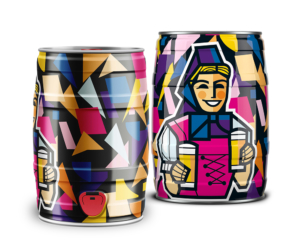
Although the “Tannenzäpfle” is traditionally linked to the 0.33l bottle, the 5-liter keg from Envases also plays an important role in the brewery’s marketing. “It’s simply a product for the group, for joint outdoor ventures,” explains Daniel Weishaar. “It’s an uncomplicated way to transport large quantities – for example, on a trip or at a barbecue with friends. In addition, you always have the charm of a freshly tapped beer.” These advantages of the minikeg are particularly appreciated by the younger target group. And that’s exactly who they want to appeal to with the new colorful Minikeg special designs. Like other successful breweries, Rothaus is using a cross-media marketing approach. This includes classic displays in supermarkets in the core market of Baden-Württemberg as well as a social media campaign.
Daniel Weishaar knows that limited editions play a major role in the production of special editions. That’s why only 1500 pieces of each of the four designs in the current collection were produced. Fortunately, this is no problem at all with Envases, emphasizes the sales expert. Due to the limited edition, the special editions regularly advance to become popular collector’s items. “At best, the customer absolutely wants to have all four designs for his collection right away,” speculates Daniel Weishaar. In any case, he is certain that the four new special designs, which will be launched at the end of May, will, as always, sell very well. And he also reveals that the next minikeg ideas are already in the starting blocks: Since “Biergit” celebrates its 50th birthday in 2022 and thus already looks back on five decades, there will possibly even be another special design in the course of the year. The Minikeg friends of Rothaus can therefore be excited…
